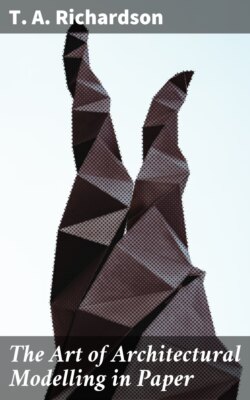Читать книгу The Art of Architectural Modelling in Paper - T. A. Richardson - Страница 6
На сайте Литреса книга снята с продажи.
PART I.
OF THE MATERIALS REQUIRED.
ОглавлениеTable of Contents
The materials the architectural modeller will require for his work, are, for the most part, few, simple, and inexpensive. They are also easily procured at any of the Artists’ Repositories. It is not, therefore, so much in the material employed, but in the skill displayed in the working, that the beauties of a model consist. The principle in this description of modelling being, that every possible part be constructed of paper, it is necessary that this should be procured of the description best suited to the nature of the work, and of the best possible quality. Inferior papers are hard, contain knots and other imperfections, and are very frequently gritty; this latter imperfection, by destroying the delicate edge of the knife, prevents the work having that sharp appearance so much to be desired. The paper I use, and have always found the best for all purposes, has a surface similar to that of Whatman’s double-elephant drawing paper, and is, I believe, sold under the name of Crayon paper: a specimen is bound with this book, forming the next page; it is of a pale cream-colour, bearing a strong semblance in tint to Bath-stone, but I have procured it from this to the shades necessary for the roofs of models. It is firm, though not hard, in texture, and not being too spongy, does not absorb to too great a degree the paste used in fastening together the sheets for the various thicknesses required, thus ensuring their firmness, a matter of the highest importance, otherwise in thin strips consisting of four, five, or more thicknesses of paper, upon their being cut each would part and defeat the desired end.
The most useful tint of this paper is the one already described, as it can be easily tinted to represent bricks or rubble, &c., should it be necessary—for instance, in a building where the quoins, dressings, &c., were in stone, the rest in random rubble or brick, it would enable you to mark them with a HHH pencil, and tint before your work was made up. I have constructed several models in pure white Bristol board, but it is a tedious hard material to work in, though the result is very fine.
The next most important auxiliary is an adhesive material for fastening the sheets together to produce the necessary thicknesses of cardboard, and to fix the whole together and the several parts in their places. For the former a paste of flour made in the following manner, will be found to be the best. To every two tablespoonfuls of the best wheaten flour, add a teaspoonful of common moist or brown sugar, and a little corrosive sublimate, the whole to be boiled, and while boiling continually stirred to prevent lumps, till of the right consistency. If a few drops of some essential oil, say lavender or peppermint, be added, the usual mouldiness will not appear, and the paste will keep for a great length of time. For the latter, a gum must be used, prepared by the following proportions. To each six ounces of the best gum arabic, add an ounce or less of moist or lump sugar, one teaspoonful of lavender or other essential oil, and a table-spoonful of gin, the whole to be mixed in cold water (no heat being in any way applied) to the consistency of a thick syrup.
Other requisites are sheets of mica or talc, to be procured at the ironmonger’s, and used for windows, skylights, &c.; pieces of soft deal or beech wood, to form any small detail such as pinnacles to barge boards, &c., that it may not be advisable or possible to form in paper; wire, lead, cord, velvet, and numerous other nick-nacks, which will occur to the modeller as his work proceeds, and which will hereafter, in their place, be carefully described.
